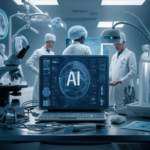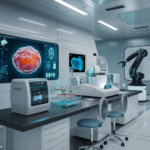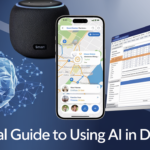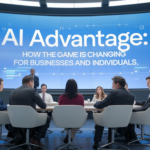Healthcare Transformation: How Reinforcement Learning Can Optimize Patient Treatment Strategies
The intersection of healthcare and artificial intelligence (AI) continues to create groundbreaking advances, and among the most promising approaches is reinforcement learning (RL). Reinforcement learning, a subset of machine learning, mimics human decision-making by learning through trial and error. In healthcare, RL is showing immense potential in optimizing patient treatment strategies by learning from patient outcomes, thereby enabling more personalized and effective care.
Understanding Reinforcement Learning in Healthcare
At its core, reinforcement learning involves an agent (in this case, an AI model) that interacts with an environment, learns from the consequences of its actions, and adjusts its strategy to achieve the best possible outcome. The agent receives feedback from the environment in the form of “rewards” or “penalties,” which it uses to refine its decisions over time.
In a healthcare setting, the “agent” could represent an AI system guiding treatment decisions, while the “environment” consists of patient data, including medical history, symptoms, diagnostic results, and previous treatment outcomes. The “rewards” are the successful treatment outcomes—improved patient health, reduced symptoms, or complete recovery. RL models, trained with this data, can learn which treatment pathways lead to optimal outcomes for specific patients or patient populations.
Optimizing Treatment Strategies
Reinforcement learning offers several key benefits in optimizing patient treatment strategies:
- Personalized Medicine: One of the main challenges in healthcare is recognizing that each patient is unique. RL can take into account a wide range of variables—from genetic information to lifestyle factors—and continuously refine treatment plans tailored to individual needs. By learning from the outcomes of different strategies across a diverse patient pool, RL can help doctors choose the best possible treatment for a specific patient.
- Dynamic Treatment Adjustments: Healthcare is not static. Patients’ conditions evolve, and treatment plans need to be adjusted accordingly. RL systems can monitor patient progress in real time and suggest adjustments to treatment plans based on how well a patient is responding. This means that treatments are no longer “one size fits all” or stagnant but can be continually refined to improve outcomes.
- Drug Dosage Optimization: Administering the right dose of medication is critical, especially in treatments involving powerful drugs such as chemotherapy, insulin, or anticoagulants. RL can help determine the most effective dosage by analyzing how different patients respond to varying doses over time. This dynamic approach minimizes side effects while maximizing therapeutic benefits.
- Multi-modal Treatments: Many chronic diseases, such as diabetes or cardiovascular disease, require multi-modal treatments that combine medication, lifestyle changes, and sometimes surgery or other interventions. RL systems can learn how different combinations of treatments impact patient outcomes and suggest the most effective combination for each patient.
Real-World Applications
Several real-world applications of RL in healthcare are already underway. For instance:
- Sepsis Treatment: RL models have been applied to optimize the treatment of sepsis, a life-threatening condition that arises when the body’s response to infection damages its tissues. RL algorithms help to determine the optimal timing and dosage of antibiotics, fluids, and vasopressors, thereby improving survival rates.
- Radiation Therapy: In cancer treatment, RL is being used to personalize radiation therapy. By analyzing how tumors respond to different doses and locations of radiation, RL can guide oncologists to more precisely target tumors while minimizing damage to surrounding healthy tissue.
- Chronic Disease Management: For chronic conditions like diabetes or hypertension, RL can help patients manage their treatment plans by continuously learning from their blood glucose levels, blood pressure, and other indicators. These systems recommend personalized interventions, such as adjustments in medication, diet, or exercise, to keep the patient’s condition under control.
The Future of RL in Healthcare
The potential of reinforcement learning in healthcare is enormous, but there are challenges to overcome. For instance, collecting enough high-quality patient data for RL systems to learn effectively can be difficult, as can ensuring the transparency and interpretability of RL models in high-stakes medical settings. Moreover, ethical concerns, such as ensuring patient privacy and avoiding algorithmic biases, must be carefully addressed.
Despite these challenges, the future of RL in healthcare looks promising. As AI technology continues to evolve and access to large datasets becomes easier, RL has the potential to revolutionize how healthcare professionals make decisions, leading to more personalized, effective,
A Doctor’s Role in Reinforcement Learning: An Example in Oncology
Consider a scenario in oncology, where doctors treat cancer patients with a variety of treatment options such as surgery, chemotherapy, radiation, and immunotherapy. Deciding the best course of action for a specific patient can be a challenge, as factors like tumor size, location, genetic mutations, and the patient’s overall health must all be taken into account.
Here’s where reinforcement learning comes into play. Imagine an oncologist working closely with an RL-based decision-support system. The RL model is trained on vast amounts of anonymized patient data, including past treatments, patient responses, survival rates, and other clinical outcomes. When a new patient is diagnosed, the RL system analyzes this data to predict which treatment plan might yield the highest chance of success, given the patient’s specific circumstances.
For instance, the RL model may recommend starting with immunotherapy for a patient whose genetic profile suggests a higher likelihood of responding to it, followed by a personalized chemotherapy regimen if needed. As the patient progresses through treatment, the system continuously monitors the outcomes, learns from them, and adjusts its recommendations. If the patient doesn’t respond well to immunotherapy, the system might suggest a quicker transition to chemotherapy or radiation, providing real-time decision support to the oncologist.
In this way, the doctor remains at the center of the decision-making process, using the RL system as a tool to enhance their judgment. The system provides data-driven insights that allow doctors to personalize treatment plans more effectively, optimizing patient care while ensuring that the treatment is adapted as the patient’s condition evolves. This collaborative approach ensures that the physician’s experience and expertise are complemented by the powerful analytical capabilities of AI.
Benefits and Future Directions
- Improved Personalization: RL enables highly individualized treatment strategies by continuously learning from each patient’s progress and medical history. Over time, this could help doctors deliver more precise and tailored therapies.
- Better Outcomes: RL’s ability to quickly adapt to new data ensures that patients receive the best possible treatment based on their current condition. This adaptability is especially valuable in conditions where treatment responses can change rapidly, such as cancer or autoimmune diseases.
- Efficient Use of Resources: RL can help streamline decision-making, potentially reducing the need for trial-and-error approaches that can delay treatment and increase healthcare costs. By recommending the most effective treatment sooner, RL may improve both patient outcomes and hospital efficiency.
- Reducing Burnout: As healthcare professionals face increased workloads, RL-driven systems could alleviate some of the cognitive burden, allowing doctors to focus more on patient care and less on data analysis. This partnership could improve decision accuracy while also reducing burnout.
Looking ahead, the integration of RL in healthcare could revolutionize many areas of treatment, from personalized medicine to complex surgeries. As more data becomes available and RL models become more sophisticated, the partnership between AI and healthcare professionals will likely deepen, leading to even more optimized treatment strategies that improve patient outcomes across the board.
In essence, reinforcement learning holds the key to transforming patient care by enhancing the doctor-patient relationship with personalized, data-driven treatment strategies. By learning from each decision and patient outcome, RL systems are paving the way for more effective, adaptive, and patient-centric healthcare.









